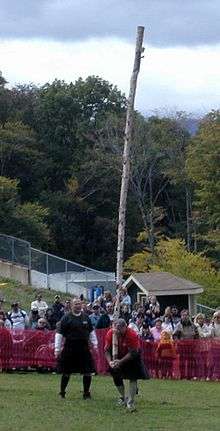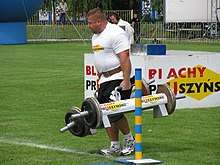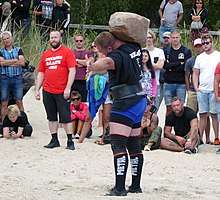Strength athletics
Strength athletics, more generally known as strongman competitions, is a sport which tests competitors' strength in a variety of different ways. Some of the disciplines are similar to those in powerlifting and some powerlifters have also successfully competed in strongman competitions. However, strongman events also test physical endurance to a degree not found in powerlifting or other strength-based sports. Competitions designed to test the strength of participants have a long history going back many centuries before the televisation of strongman competitions in the 1970s. This ancient heritage can still be seen in a number of traditional events, the most famous of which is the arguably traditional Highland Games, which itself is a source of many events now practiced in modern strongman competitions. Different competitions may be structured very differently with some strength athletic competitions, such as the World's Strongest Man, being slanted towards dynamic tests of strength, whilst others pivot around tests of pure static strength such as the Arnold Strongman Classic.
History
See also Highland games
Origins
The origin of strength athletics lies within prehistory. Testing each other in feats of physical prowess has been something humans have done throughout their existence. This is encapsulated in the modern Olympic motto of "Swifter, higher, stronger". There are records in many civilizations of feats of strength performed by great heroes, mythological or otherwise. In ancient western culture Greek heroes such as Heracles are blessed with great strength. In the Bible, figures with exceptional physical strength are described such as Samson and Goliath. Man's obsession with those who possess extraordinary strength is an ancient and persistent one.
Strongmen
See also Strongman (circus)

Displaying one's strength took two particular forms of note: as a pure exhibition and within the confines of sporting competition. Within the British Isles records, many centuries old, relay more formally the existence of organised events. Formalization and annual Highland gatherings began around 1820 when Sir Walter Scott encouraged the revival of Highland Culture. By 1848, such was the status of such games that Queen Victoria attended the Braemar Highland Games.[1] The strongmen of the world of weightlifting and circus acts were also exhibiting their prowess. A number of famous names emerged at the turn of the 19th century. Thomas Inch, still remembered today for his Grip Strength. and his Challenge Dumbbell, known as the Inch Dumbbell, that "has defied thousands of strong men over the last hundred years...Many a strength athlete tried but failed to break it off the ground.".[2] Other notable names in this genre were Louis Cyr, Joseph Greenstein, and Louis Uni (Apollon) who was famously able to knockout a horse with a single punch - an event popular in this era.
Codified sport
See also Powerlifting
In the 20th century, strength sports began to be codified into weightlifting, powerlifting and the like. However, feats of strength akin to the circus performances continued to have their place. In 1957 the Olympic gold medal winner, Paul Anderson backlifted 6,270 pounds as a one-off feat. David Prowse was initially famous in 1964 for his lifting the famed 785 pound Dinnie Stones, the first man to do so since Donald Dinnie himself a century earlier.[3] Prowse later became more famous still for playing Darth Vader in Star Wars, also appearing in several public information films commissioned by the Central Office of Information which instructed children on how to cross the road.
Emergence of strength athletics as a new sport
See also Strongman (strength athlete)
The late 20th century saw the emergence of strength athletics. Combining formalised strength events found in Highland Games, with elements of powerlifting and weightlifting, along with an eclectic selection of events involving the lifting of rocks, refrigerators, pulling vehicles (trains, lorries, planes etc.), this modern spectacle has in the popular imagination taken the mantle of the strongmen of old. Many events are based on the older circus feats, but giving them a competitive twist. For many the terms strongman and strength athlete are interchangeable although emphasis on the latter in sport specific literature has attempted to maintain a distinction.
World's Strongest Man
See also World's Strongest Man
The most famous event is one of the oldest, namely the World's Strongest Man competition,[4] still described by a number of highly respected authorities in the sport as the premier event in strongman.[5][6]
The concept behind "The World's Strongest Men", as it was originally named, was developed in 1977 for CBS by Langstar Inc. David Webster, a Scot who later received an OBE for his services to sport, was the head coordinator of the competition from its inception. Dr Douglas Edmunds, seven-times Scottish shot and discus champion and twice world caber champion[7] worked with Webster and when David Webster retired from his position Edmunds took over. These two men were responsible for inviting the competitors and choosing the events. They selected men who had shown prowess in the mainstream fields of strength sports such as the heavy field athletics events, such as shot put, as well as powerlifters, bodybuilders and wrestlers. The idea was to create a spectacle that would test the purveyors of these now disparate disciplines against one another on the elements that remained common to all, strength.
The show was a great success making household names of men such as Geoff Capes, Bill Kazmaier and Jón Páll Sigmarsson. It was replicated at national level as well, with events such as Britain's Strongest Man first being televised in 1979 by the BBC. In the meantime, in 1982, CBS sold the rights to the BBC, who in turn sold the rights to TWI. In the early days, the competitors were shifting from unpaid amateur sports to what was deemed a professional sporting activity. To maintain the competitive base as well tapping the obvious public interest, other events sprang up and by the mid-1980s a number of other international gatherings had become regular features, most notably the World Muscle Power Championships and the World Strongman Challenge.
IFSA and the schism
In 1995, Edmunds and Webster, along with representatives from the competitors including Jamie Reeves, Ilkka Kinnunen and Marcel Mostert formed a governing body called the International Federation of Strength Athletes ("IFSA"). The IFSA began organizing its own bespoke events, such as the IFSA European Championships but also took the lead in working with BBC and TWI to organize the World's Strongest Man competition. For almost a decade the IFSA and WSM were inextricably mixed, but this changed in 2004. The InvestGroup Ventures' sports rights management arm, InvestGroup Sports Management, invested heavily into IFSA and this led to the creation of IFSA Strongman. The strategy was to acquire most of the international assets and properties relating to the strongman sport. In essence this was a new organisation[8] with some, such as Magnus Samuelsson describing it as "a new company...with the same name as our old federation".[9] The attempt at dominance was not well received by TWI and disagreement ensued leading to a split in the sport. Previously, in 2001, the IFSA in its former guise had entered an agreement with World Class Events (WCE), headed by Ulf Bengtsson, to run the Super Series. This Super Series was designed to award the World Championship title, but also acted as a qualifying vehicle for the WSM. When strongman split in 2004, the Super Series sided with TWI forming a rival federation to the IFSA.[8] With the WSM being a TWI owned event, IFSA Holdings announced its own world championships for 2005, to be held in Quebec, and thus from that point had no involvement in the WSM contest.
The split with IFSA, which banned its registered athletes from competing at WSM, meant that not all the recognised best strength athletes in the world were eligible to compete. However, the reputation of WSM as the premier event maintained its lure for broadcasting purposes. In recent years, the competition has been broadcast on ESPN, ESPN2 and Five. The longevity of the contest in strength athletics and its high levels of TV exposure over the years has led to it being described as "the granddaddy of all strongman contests".[8] The contest has been criticised in recent years for its slant towards athleticism away from raw strength, with other contests whose emphasis is on the latter, such as the Arnold Strongman Classic or Fortissimus, being cited as producing the true strongest man in the world. However, it is routinely described as "the Worlds" by top strongman competitors[8] and despite the critics, it is the leading brand name in the field. No other strongman contest commands close to the WSM's levels of TV exposure.[8]
Present-day
To be developed In recent years, interest in the sport at the grassroots level has skyrocketed, leading to the spontaneous formation of local clubs, loosely affiliated with provincial/state and national associations. Many sports-specific training facilities have begun to incorporate movements associated with strongman competitions into their general training schemes, albeit with lighter weights used; e.g. tire flips, sled drags, object loading or carrying, log pressing, farmer's walks and so on.
Strongman competitions have grown in popularity in recent years, due in part to the introduction in 2001 of the Strongman Super Series, an equivalent to the international "tour" in other individual sports, and to the influx of new competitors from eastern Europe who have broken the Scandinavian dominance of the sport in the 1990s. The top scorer in the Super Series is named Super Series Champion.
Common disciplines



There is no set rule about what specific events will occur in a contest, except that to prevent single-event specialists from gaining an advantage, each event will be different (a single contest will not include two squat events, or two overhead lifting events, for example). Normally, a strongman contest comprises six events, though at the top level of competition, seven or eight events may be held. Among the most common events are:
- Farmer's Walk - competitors race along a course while carrying a heavy weight in each hand. A variation is the Giant Farmer's Walk, with a much heavier weight carried over a shorter distance.
- Hercules Hold or Pillars of Hercules - contestants stand between two pillars, pivoted to fall outwards. The competitor must simply hold them up for as long as possible.
- Vehicle Pull - probably the most famous of all strongman events. The competitor pulls a vehicle from a stationary start, for a prescribed distance - fastest over the course wins. In smaller competitions the vehicle is usually a truck; however, in major contests such as World's Strongest Man anything goes, including trains and airplanes.
- Atlas Stones - a lifting stone event whereby five spherical concrete stones of increasing weight are placed on top of podia of varying height, beginning with the lightest stone lifted to approximately a normal person's head height. Alternatively, the stone is lifted over a bar for reps. The stone lift often finishes strongman competitions.
- Stone Carry - On Iceland, the original rock lift was instead done with a rock called the Husafell stone, that was to be carried for a stretch, to achieve the title full-strong, fullstarkur. This rock was not round but irregular, sometimes this concept is used today, like with a "rock" the shape of Africa.
- Refrigerator Carry - a staple of earlier WSM events that has made a comeback in recent years. The competitors carry two refrigerators, attached to an iron bar they hold on their shoulders, and walk it across the finish line as fast as they can.
- Carry and Drag - an object (usually a heavy anchor) is run across half of the course. The competitors then must attach it to a chain of almost equal weight and pull it across the rest of the course.
Training
Training for strongman involves building overall strength in the gym, and training with competition implements to gain familiarity. In the gym, it is necessary to train the entire body for strength, especially with variants of the squat, deadlift and overhead press.
Also important is explosive power, developed by weightlifting-style lifts, and cardiovascular conditioning. Grip strength must also be developed.
Like any sport, it is necessary to train using the equipment one encounters in the sport. In the case of strongman, these include logs, tires, yokes, farmer's walk implements, etc.; building strength in the gym is insufficient without experience with implements.
Major titles and title holders
Other major international events not listed above include the Highlander World Championships, Giants Live, World Strongman Federation events, World's Mightiest Man, and Strongest Man Alive, as well as a number of international team competitions and various continental championships, such as Europe's Strongest Man.
See also
- High striker
- Strength athletics in the United Kingdom and Ireland
- Strongman (strength athlete)
- World's Strongest Man
- World Strongman Federation
- Beauty and the Beast was billed as the World Strongman Challenge.
- List of strongmen
References
- ↑ Crieff Highland Gathering Archived 2007-12-03 at the Wayback Machine.
- ↑ "www.oldtimestrongman.com". Retrieved 15 July 2018.
- ↑ British Strongmen Archived 2010-08-13 at the Wayback Machine.
- ↑ "Competition History". Archived from the original on 2009-02-08.
- ↑ "World's Strongest Man Update". www.ironmind.com. Retrieved 15 July 2018.
- ↑ samson-power.com/archived_news.htm Archived 2005-10-26 at the Wayback Machine.
- ↑ "Bring on the war games". HeraldScotland. Retrieved 15 July 2018.
- 1 2 3 4 5 "IFSA, WCE, TWI, WSM, ESPN: Who's On First and How Do I Get To World's Strongest Man?". www.ironmind.com. Retrieved 15 July 2018.
- ↑ "HugeDomains.com - magnus-samuelsson.net is for sale (magnus-samuelsson)". www.magnus-samuelsson.net. Retrieved 15 July 2018.
Old Time Strongman Training
United States All Round Weightlifting Association